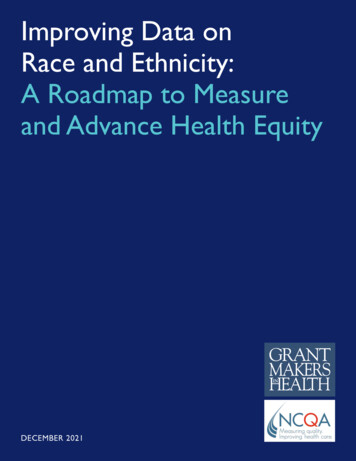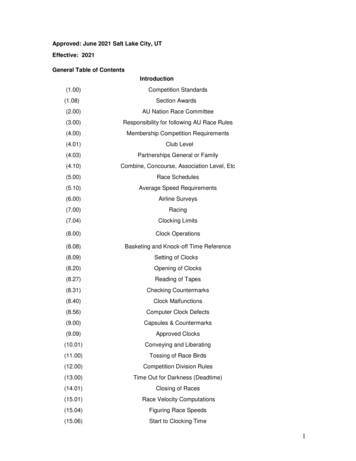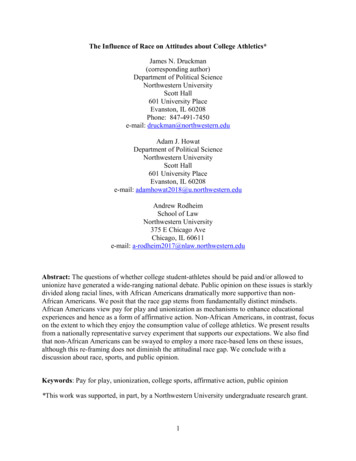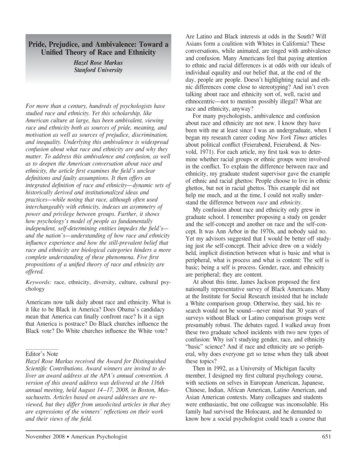
Transcription
Improving Data onRace and Ethnicity:A Roadmap to Measureand Advance Health EquityDECEMBER 2021
Improving Data on Race andEthnicity: A Roadmap to Measureand Advance Health EquityThis project, conducted jointly by Grantmakers In Health (GIH) and theNational Committee for Quality Assurance (NCQA), with support fromThe Commonwealth Fund, details how race and ethnicity data are collectedacross federal health programs. This report builds on an earlier report,Federal Action is Needed to Improve Race and Ethnicity Data in HealthPrograms (October 2020). The project team included Cara James andSmita Pamar, GIH; Sarah Hudson Scholle, Philip Saynisch, and Jeni Soucie,NCQA; and Barbara Lyons, consultant.GIH NCQA2
IMPROVING DATA ON RACE AND ETHNICITY: A ROADMAP TO MEASURE AND ADVANCE HEALTH EQUITYGIH.ORGExecutive SummaryRacial and ethnic health disparities have been documented in the United States for over acentury. In 1985 the Heckler Report provided the first national summary of these disparities,leading to the creation of the Department of Health and Human Services Office of MinorityHealth. In the 1990s and 2000s the study of gaps in health care access, utilization, andoutcomes by race and ethnicity grew rapidly, but confronted a critical limitation of the availabledata: the lack of standardized, self-identified race and ethnicity.The COVID-19 pandemic provided stark proof that data limitations are far from beingaddressed, which has real consequences for the study and practice of public health. Thoughdata have improved since the beginning of the pandemic, the Centers for Disease Controland Prevention can only identify the race and ethnicity of less than 60% of individuals testingpositive for COVID-19 or receiving vaccines, significantly limiting the ability of policymakersand health care stakeholders to measure and improve equity in the pandemic’s effectsand mitigation.This Roadmap builds on an earlier report, Federal Action Is Needed to Improve Race and EthnicityData in Health Programs,1 in three critical respects. First, it expands on that report’s summary ofthe current state of race and ethnicity data in health care programs, offering more detail aboutwhether and how race and ethnicity data are collected across a range of insurance programs,federally administered health systems and public health databases. Second, it summarizes arange of barriers to improving collection and use of race and ethnicity data, and identifiesgeneral principles for improving the data. Finally, it expands the range of recommendations forimproving the data, considering not only actions the federal government could take, but alsoidentifying actions for states and the private sector.To advance these goals, the project team carried out a targeted search for information on thecompleteness and quality of race and ethnicity data; an environmental scan to identify previousreports summarizing challenges to collection and use of race and ethnicity data; and keyinformant interviews to better define and understand barriers and opportunities.The environmental scan and informant interviews pointed to a consistent set of barriers facedby health care organizations, including: Legal and privacy concerns around collection and use of race and ethnicity data. Lack of standardized collection procedures and category definitions. Technical barriers to collection and storage of data. Cost of collection and lack of financial incentives or program requirements to collect raceand ethnicity data. Lack of staff and resources in health care organizations to analyze and use data oncecollected. Resistance from patients and clinical providers to collection and use of race andethnicity data.GIH NCQA3
IMPROVING DATA ON RACE AND ETHNICITY: A ROADMAP TO MEASURE AND ADVANCE HEALTH EQUITYGIH.ORGDespite these challenges, prior reports and data from the key informant interviews pointedto several opportunities to improve collection and use of race and ethnicity data: Highlight early, successful adopters of expanded race and ethnicity data collection. Disseminate existing technical support resources and data standards. Educate patients and providers about the potential of improved race and ethnicity data toimprove outcomes and equity. Provide incentives to encourage data collection and finance necessary technologyinvestments and staffing. Where incentives fail to produce action, consider mandates (e.g., require collectionto meet certain standards as a condition of participating in federal programs ordemonstration projects). Identify existing resources that could be leveraged to improve analysis of health equityuntil consistent, complete, self-reported race and ethnicity data are available.The report concludes with a series of recommendations for federal and state regulatorsand legislators, health systems and health insurance companies, and a range of other healthsector stakeholders. Recommendations are grouped under the following themes: Improve data collection, storage and transfer systems. Evaluate and expand incentives and requirements to collect. Provide updated technical assistance to stakeholders. Review, clarify and, if necessary, amend regulations.GIH NCQA4
IMPROVING DATA ON RACE AND ETHNICITY: A ROADMAP TO MEASURE AND ADVANCE HEALTH EQUITYGIH.ORGI. Background and the Role of This ReportAn accumulating body of evidence demonstrates that racial and ethnic minority populations havebeen disproportionately impacted by the COVID-19 pandemic. These groups are at greater risk ofexposure to COVID due to factors like overrepresentation among essential workers and crowdedliving conditions.2 Additionally, the pandemic has been marked by racial and ethnic disparities inrates of severe illness leading to hospitalization or death, likely due to differential health care access,preexisting disparities in health status and a range of other contextual factors.3These racial and ethnic health disparities have been documented for well over a century in theUnited States, though the 1985 Heckler Report was the first national report to summarize healthdisparities. Since that time, the language used to describe these differences—“health disparities”in the 1990s and 2000s, “health equity” more recently—has changed, but racial and ethnic gaps inhealth care access, quality, and outcomes have persisted and remain largely unchanged.At the same time as the pandemic exacerbated existing disparities, it also highlighted majordeficiencies in health care data systems. As of July 2021, the Centers for Disease Control andPrevention (CDC) only had race data for 64% of COVID case reports,4 and eight states had racedata on fewer than half of COVID cases as of October 2021.5 These examples underscore a keychallenge to monitoring and improving health equity: a critical lack of complete, standardized,self-identified race and ethnicity data across federal and state health care and public healthprograms. Dating back to the Heckler Report, our ability to monitor and address health disparitieshas been limited by missing and incomplete data, particularly for small population groups, such asAmerican Indians and Alaska Natives.This report, a collaboration between Grantmakers In Health and the National Committee forQuality Assurance (NCQA), was funded by the Commonwealth Fund to identify these datalimitations, describe barriers to improving data on race and ethnicity across health care systems,and provide recommendations for charting a course forward. In the first project report,1 thisgroup identified the potential scope for short-term actions at the federal level. However, there arebarriers to collecting improved race and ethnicity data (and opportunities to use these enhanceddata to measure and improve health equity) throughout the health care system. With that expandedperspective in mind, this report builds on the first document, incorporating insights on challengesand opportunities to expand the availability and use of race and ethnicity data from a range ofsources. These include prior reports on race and ethnicity data quality and comprehensiveness, adetailed assessment of existing data resources across the health sector and a series of interviewswith key health system stakeholders that shared their view of barriers and opportunities.This report aims to describe the current state of completeness and quality of race and ethnicity dataacross a variety of health sector settings. Additionally, the work described seeks to identify barriersto improving data and opportunities that federal and state governments, as well as other healthsector stakeholders, might leverage to lessen them. The report concludes with recommendations toimprove the availability and use of race and ethnicity data as a key tool in measuring and improvinghealth equity.GIH NCQA5
IMPROVING DATA ON RACE AND ETHNICITY: A ROADMAP TO MEASURE AND ADVANCE HEALTH EQUITYGIH.ORGII. MethodsData framework and scan of currently available race and ethnicity dataThe first goal of this project was to provide an up-to-date overview of the quality andcomprehensiveness of data on race and ethnicity across a range of health care settings. In pursuitof this goal, the project team (in consultation with the Commonwealth Fund) identified four keycharacteristics of race and ethnicity data collected and used by the health sector:1 The standards used to collect the data.2 The completeness of the data.3 W hether data were self-reported.4 W hether data were available to researchers or the public.In this context, the collection standards refer to the categories of race and ethnicity reported ina given setting. One widely used standard was published in 1997 by the Office of Managementand Budget (hereafter, OMB 1997). The OMB 1997 standards call for a two-question approachwhen feasible. In this format, respondents separately indicate which of five race categories(American Indian or Alaska Native, Asian, Black or African American, Native Hawaiian or OtherPacific Islander, White) they identify as, with the option to select multiple races. In a secondquestion, respondents indicate whether they are of Hispanic or Latino ethnicity.6 More recentstandards published in 2011 by the Department of Health and Human Services (HHS) Office ofthe Assistant Secretary for Planning and Evaluation (ASPE) (hereafter, HHS 2011) retain the twoquestion approach but greatly expand the granularity of the available categories.7 Notably, eventhese expanded race and ethnicity standards lack the detail needed to reflect all individuals’ selfidentification and to understand differences in health care utilization and outcomes. For example,neither standard includes a separate “Middle Eastern or North African” category. Newer, morecomprehensive standards exist; for example, standards in the Office of the National Coordinatorfor Health Information Technology’s (ONC) 2015 Edition final rule include over 900 ways ofrepresenting race and ethnicity. However, these newer standards are not widely used. Table 1compares the 2 standards and shows the correspondence between the categories in each.The completeness of the data refers to the percentage of the population included in a dataset forwhom there were usable race and ethnicity data; that is, the percentage with a recorded race/ethnicity category, excluding those labeled as unknown, missing, declined to answer or similar.Additionally, we assessed whether data were self-reported. Self-identification is considered the goldstandard for race and ethnicity data collection and is recognized as the preferred approach by boththe OMB 1997 and HHS 2011 standards.6,7 In most cases, our assessment describes whether theentity responsible for collecting and reporting race and ethnicity data instructed staff to recordself-reported data. In practice, data collection may deviate from those instructions, but rigorouslydocumenting these practices is beyond the scope of this overview.GIH NCQA6
IMPROVING DATA ON RACE AND ETHNICITY: A ROADMAP TO MEASURE AND ADVANCE HEALTH EQUITYGIH.ORGFinally, we assessed whether the data described were available to researchers or the public, and onwhat basis. Some data were technically available, but only to employed or affiliated researchers;others are available as a “researcher identifiable file” (RIF, i.e., one with identifying informationreplaced with pseudo-identifiers that facilitate consistent identification of an individual patient orprovider over time and linkage between data sets) on a restricted basis, while others are availableas public-use files (PUF).Table 1: Comparison of OMB 1997 and HHS 2011 Race and Ethnicity Collection StandardsRace*Ethnicity*OMB 1997HHS 2011WhiteBlack or African AmericanAmerican Indian or Alaska NativeWhiteBlack or African AmericanAmerican Indian or Alaska NativeAsianAsian IndianChineseFilipinoJapaneseKoreanVietnameseOther AsianNative Hawaiian orOther Pacific IslanderNative HawaiianGuamanian or ChamorroSamoanOther Pacific IslanderNot Hispanic or LatinoHispanic or LatinoNo, not of Hispanic, Latino/a, or Spanish originYes, Mexican, Mexican American, Chicano/aYes, Puerto RicanYes, CubanYes, Another Hispanic, Latino/a or Spanish origin* OMB 1997 and HHS 2011 permit the reporting of more than one race; HHS 2011 also permits people to select one or more ethnicity.We conducted an environmental scan to populate the framework for health care and publichealth programs that measure and monitor health care quality, primarily focusing on programs atthe federal level. This search generally excluded population-based surveys (such as the NationalHealth Interview Survey [NHIS] and the Medical Expenditure Panel Survey [MEPS]) that alreadyhave a standard for data collection and cover narrow samples of eligible populations. Wherepossible, this scan was supplemented with targeted outreach to experts at the relevant agencies(e.g., Veterans Health Administration [VHA], CDC).GIH NCQA7
IMPROVING DATA ON RACE AND ETHNICITY: A ROADMAP TO MEASURE AND ADVANCE HEALTH EQUITYGIH.ORGOne aspect of the data that was not included in these assessments was the accuracy of raceand ethnicity data; that is, the concordance between the currently available race and ethnicitydata and a reference set of self-reported race and ethnicity data for the same population.Several considerations drove this omission. First, while some efforts to assess accuracy areavailable (e.g., comparison of administrative data for Medicare beneficiaries to self-reportedrace and ethnicity data from the Outcome and Assessment Information Set [OASIS]8), suchvalidations are not consistently available for the data resources we considered. Moreover,in some settings, race and ethnicity data are incomplete or unavailable, rendering suchcomparisons moot. Nonetheless, future efforts should assess the accuracy of currentlyavailable race and ethnicity data, perhaps through original research aiming to validate thesedata. Additionally, while issues surrounding algorithms and bias in health care are a major topicof concern for health care providers, scholars and policymakers, a detailed treatment of thisconversation is beyond the scope of this report. However, this work and the topics coveredhere are critically linked—without accurate, comprehensive data on self-reported race andethnicity, we will struggle to know the extent of disparate impact these algorithms may haveon health care utilization and outcomes.Review of prior reports on health equity, with an emphasis on race andethnicity dataIn addition to the review of race and ethnicity data currently collected, the project teamalso conducted a targeted literature search on the subject that considered reports issued bythe Institute of Medicine/National Academy of Medicine (IOM/NAM), the National QualityForum, NCQA and the HHS ASPE. In particular, the literature search emphasized the sectionsof these reports that described the state of race and ethnicity data collected by health carestakeholders and the barriers to and opportunities for improving data collection. The reviewwas limited to reports published since 2001, to ensure that commentary on race and ethnicitydata was potentially relevant to current challenges. The full list of reviewed reports appears inAppendix Table 2.Key informant interviewsFinally, in consultation with the Commonwealth Fund, the project team identified a list of 19key informants representing federal, state, and local health agencies; commercial insuranceplans; public and private health systems; and health information technology experts. Weconducted 60-minute, semi-structured interviews with each informant to identify barriers toand opportunities for improving race and ethnicity data collection and use that were mostrelevant to their area of expertise. Additionally, in response to feedback from informants,we conducted 4 targeted, 30-minute interviews with key technical experts. These interviewsallowed the project team to confirm and, as needed, update the insights gleaned from thereview of prior reports.GIH NCQA8
IMPROVING DATA ON RACE AND ETHNICITY: A ROADMAP TO MEASURE AND ADVANCE HEALTH EQUITYGIH.ORGIII. Findings on Data Completeness and Quality, Barriers andOpportunitiesData completeness and qualityThe following sections summarize the project team’s findings on the completeness and accuracy of raceand ethnicity data in health programs.Table 2 provides a summary of quality and completeness of race andethnicity data; a more comprehensive treatment appears in Appendix Table 1.Table 2: Race and Ethnicity Data Collected at Enrollment in Selected Federal ProgramsSETTINGDATA COLLECTIONSTANDARDCOMPLETENESS SELF-REPORTED? DATA AVAILABLEFOR RESEARCH?MedicaidFederally-Facilitated and State-BasedMarketplaces (FFMs; SBMs)Standards havechanged over timeHHS 2011bFFMs HHS 2011;SBMs varyCommercial InsuranceUnknown UnknownVeterans Health AdministrationOMB 1997 Indian Health ServiceBlood Quantum &Tribal Affiliation cUnknown Federally Qualified Health CentersOMB 1997 d dBirth RecordsHHS 2011 e COVID-19 VaccinationsOMB 1997 Unknown Pregnancy Risk AssessmentMonitoring SystemOMB 1997 f LEGEND:NOTES: Less complete Varies (by state, collection method, etc.) More complete Yes Noa D ata are obtained by SSA from the parentsat birth, but data are not available for mostbeneficiaries born after 1989 due to SSAprocedure changes. Also includes imputationto improve reporting for Asian and/or PacificIslanders & Hispanic beneficiaries.Medicareb Data categories roll up to OMB1997 standards.GIH NCQA a c Limited to data from individuals receivingcare at IHS providers; 78% AmericanIndians and Alaska Natives live outside tribalstatistical areas.d Data aggregated at center level.e Based on mother and father’s self-report.f Extracted from birth certificate.9
IMPROVING DATA ON RACE AND ETHNICITY: A ROADMAP TO MEASURE AND ADVANCE HEALTH EQUITYGIH.ORGMedicareRace and ethnicity data are relatively complete for Medicare beneficiaries, though there are welldocumented issues with changing data sources and collection standards over time. Before 1989,Medicare’s Enrollment Database (EDB) was populated from Social Security Administration (SSA)records derived from form SS-5 (application for Social Security). Prior to 1980, these formsallowed only White, Black or Other as race categories, with all enrollees not identifying coded as“Unknown.” In 1980 these categories were expanded to White (non-Hispanic), Black (non-Hispanic),Hispanic, Asian/Asian American/Pacific Islander and American Indian or Alaska Native. However,when SSA switched to enrollment at birth, the race and ethnicity data contained in birth certificateswere not recorded in SSA enrollment records. As a result, race and ethnicity data are missingfrom the EDB for beneficiaries born after 1989.9 As of 2019, the Centers for Medicare & MedicaidServices (CMS) had race and ethnicity data on roughly 98% of Medicare beneficiaries.10To the extent that health systems collect data on patients’ race and ethnicity, these data are notsubmitted to CMS with Medicare claims. As a result, the race and ethnicity data that appear inMedicare claims databases like those maintained by the Research Data Assistance Center (ResDAC)are drawn from the Medicare EDB, not from data recorded at the point of care. Conversely, raceand ethnicity data are collected using the OMB 1997 standard across a variety of quality reportingand assessment data sets, including the Long Term Care Minimum Data Set, the Home HealthOutcome and Assessment Information Set and the CMS Hospice Item Set.11–13 Moreover, these dataare generally self-reported.To address deficits in race and ethnicity information in Medicare data, algorithms such as theMedicare Bayesian Improved Surname Geocoding (MBISG)14 and Research Triangle Institute (RTI)9methods have been developed to impute race and ethnicity from beneficiaries’ name and place ofresidence. In the absence of self-reported data, these imputation approaches may be valuable toolsfor measuring health equity across populations.Medicare enrollment, utilization and assessment data are generally available as RIFs from ResDAC,but accessing these data resources can be expensive,15 which is challenging for researchers withoutfunding for access. Additionally, because of the size of the datasets, analyses can be computationallyintensive, requiring either investment in information technology or additional fees for access tocomputing environments like the Virtual Data Research Center.MedicaidSince 2019, Medicaid data have been made available by CMS through the Transformed MedicaidStatistical Information System (T-MSIS), which aims to improve on prior Medicaid data sources bystandardizing data, making more timely data available, and other quality enhancements.12 However,despite these improvements, the quality and completeness of race and ethnicity data varies fromstate to state. To summarize the state of race and ethnicity data in T-MSIS, the Medicaid DataQuality Atlas uses two criteria: the percentage of beneficiaries missing race and ethnicity data, andthe number of race and ethnicity categories for which there was a 10 percentage point or greaterdifference between the T-MSIS enrollment data and the American Community Survey estimates forthat state. On this basis, state data are classified as low concern, medium concern, high concern orunusable. As of 2018, 17 states had “low concern” data quality and 22 states had “high concern” orGIH NCQA10
IMPROVING DATA ON RACE AND ETHNICITY: A ROADMAP TO MEASURE AND ADVANCE HEALTH EQUITYGIH.ORG“unusable” race and ethnicity data. In the 5 states with “unusable” data, more than 50% of enrolleeswere missing this information.17 States report data based on the HHS 2011 standards when raceand ethnicity are collected.18Race and ethnicity data are not included in T-MSIS datasets reflecting use of health care services,quality of care and health outcomes or cost of care, but use of services and cost of care datasetscan be linked to enrollment data with individual identifiers. As with Medicare data, T-MSIS analyticfiles are available as RIFs from ResDAC.Marketplace plansThe latest CMS data indicate that about 12 million Americans are enrolled in insurance coveragepurchased via health insurance Marketplaces.19 As with race and ethnicity data in Medicaidprograms, the quality and completeness of data linked to enrollment in Marketplace insuranceplans varies considerably from state to state. According to state-level open enrollment PUFs, thepercentage of enrollees with missing race data ranges from 11%–59% and ethnicity data are missingfor between 4% and 42% of enrollees.20 Additionally, collection and reporting standards varydepending on whether coverage is offered through state-based or federally facilitated Marketplaces(SBMs or FFMs). SBMs report race and ethnicity as a single variable, while FFMs use the HHS 2011standards. Colorado does not report any race or ethnicity data to CMS.21With respect to data availability, enrollment by race and ethnicity is publicly reported at the statelevel, but there is no publicly accessible central repository for Marketplace claims data. Moreover,while quality, outcome and cost of care data are all subject to public reporting, the data are notstratified by race and ethnicity.Other commercial insurance plansThe majority of working-age adults (61.2% as of 2019) receive health insurance coverage throughan employer.22 Unfortunately, race and ethnicity information on this large population is largelyincomplete. Recent research found that as of 2019, 76% of commercial plans had race data for lessthan 50% of members and 94% had ethnicity data on less than 50% of their membership.23 Becauseof the largely incomplete nature of the data, information on collection standards is not centrallyavailable and practices are likely to vary considerably from plan to plan.Data on enrollment and health care utilization for commercial insurance enrollees are considerablymore difficult to access than Medicare and Medicaid data. Claims data are available for a small subsetof states through all-payer claims databases (APCD), but availability of race and ethnicity data is highlyvariable. For example, Minnesota does not include any race or ethnicity data in its APCD.24 A 2017analysis of 5 APCDs by the National Association of Health Data Organizations found that only 28%of records had usable race data.25 Moreover, as of 2018, only 18 states either had legislation creatingAPCDs or were in the process of establishing an APCD26 (only 9 had publicly posted rules for releasingdata).27 Data can also be accessed via commercially available claims databases; like APCDs, however, ifthe databases draw on data available to commercial insurance carriers, they will reproduce the samelimitations with respect to race and ethnicity information.GIH NCQA11
IMPROVING DATA ON RACE AND ETHNICITY: A ROADMAP TO MEASURE AND ADVANCE HEALTH EQUITYGIH.ORGFederal health care delivery systemsThe sections above describe how the federal government collects data in its role as a purchaserof health care services, but for several key populations of interest, it also serves as the providerof health care services. This section details race and ethnicity data collected in several federaldelivery systems.The VHA provides health care services to veterans. It collects race and ethnicity data using theOMB 1997 standards, and data have become more complete over time. Prior to 2003, less than60% of patients had usable race and ethnicity data; since 2015, that figure has climbed above 90%.29VA Medical Centers are instructed to collect self-reported race and ethnicity data, but this variesin practice. Enrollment and utilization data are typically not available to researchers outside theVHA system.The Defense Health Agency (DHA), which provides care to active-duty members of the armedforces, collects eligibility and enrollment data in the Defense Enrollment Eligibility System. Data arecollected using more national origin categories than are captured in the OMB 1997 standards butdo not match the expanded HHS 2011 standards. Data reflect the race and ethnicity of the enrolledservice member and may not match the self-identification of other family members enrolled asdependents. The project team was unable to locate data on the completeness of DHA race andethnicity information.Federally Qualified Health Centers (FQHC) are community-based health care providers fundedby the Health Resources and Service Administration (HRSA). These centers serve essential safetynet functions, including offering sliding scale-based payment structures to patients.30 FQHCs arerequired to report center-level data to the Uniform Data System (UDS), which includes race andethnicity data, using a modification of the OMB 1997 standards. These reflect self-reported datacollected at registration,31 and aggregate statistics from 2019 suggest that race and ethnicity data areavailable for roughly 85% of FQHC patients.32The Indian Health Service maintains the National Patient Information Reporting System (NPIRS).Because the IHS primarily provides care to members of federally recognized American Indianand Alaska Native (AIAN) tribes, IHS data reflect blood quantum and tribal affiliation rather thanthe race and ethnicity data used in other databases described here. Additionally, the NPIRS onlyincludes data for individuals receiving care at IHS facilities. Because 78% of AIAN individuals do notreside in tribal statistical areas,33 the NPIRS only provides data for a subset of AIAN populations.GIH NCQA12
IMPROVING DATA ON RACE AND ETHNICITY: A ROADMAP TO MEASURE AND ADVANCE HEALTH EQUITYGIH.ORGFederal public health dataIn addition to its collection of race and ethnicity data in its role as a payer, the federalgovernment also administers a wide array of public health databases, many of whichincorporate data on race and ethnicity. Race and ethnicity data are largely complete in vitalstatistics records, which include records of births and deaths. Births are recorded with themother and father’s self-reported race and ethnicity using HHS 2011 standards. Deaths arerecorded using the OMB 1997 standards and may be reported by the funeral director ratherthan by the family of the deceased. Race and ethnicity data are largely complete for deathsand for the mother’s race and ethnicity in birth records. The father’s race and ethnicityare somewhat less complete in birth records, with 82% of records having usable race and87% having usable ethnicity.34 Aggregated national-level data are available as PUFs andresearchers can apply for access to more granular, restricted-use files as well.35The Pregnancy Risk Assessment Monitoring System (PRAMS) is a surveillance system thatsamples live births to support improvement in birth outcomes. Race and ethnicity are notincluded in the PRAMS questionnaire, bu
This report, a collaboration between Grantmakers In Health and the National Committee for Quality Assurance (NCQA), was funded by the Commonwealth Fund to identify these data limitations, describe barriers to improving data on race and ethnicity across health care systems, and provide recommendations for charting a course forward.










